We use cookies to make your experience better. To comply with the new e-Privacy directive, we need to ask for your consent to set the cookies. Learn more.
The rise of tea to the drink of intellectuals
The rise of tea to the drink of intellectuals
7th to 10th century
The Tang dynasty (618 - 907) was not only the Golden Age of Chinese culture - the capital of Chang'an (today: Xi'an) was considered the cultural capital of the whole East Asian region - it was also the time when tea culture in China originated.
Two important events contributed to this. Both have to do with the person Lu Yu.
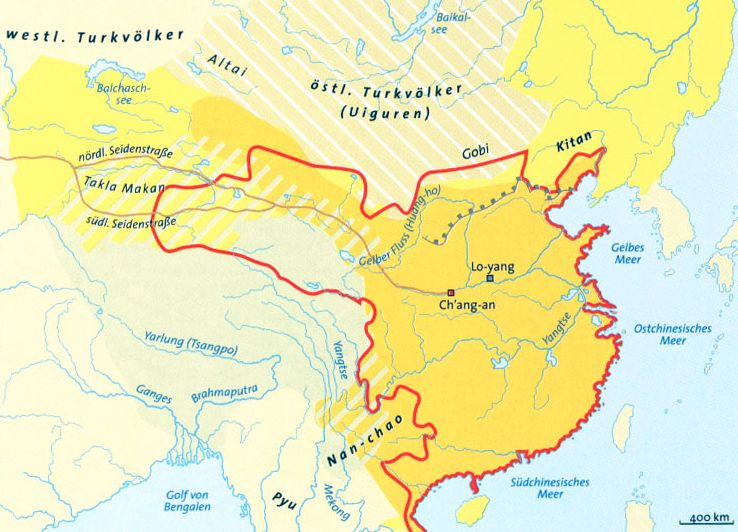 The red line shows the extent of the Sui Dynasty (541 - 618). The yellow colour shows the expansion of the Chinese empire during the Tang Dynasty (618 - 907)
The red line shows the extent of the Sui Dynasty (541 - 618). The yellow colour shows the expansion of the Chinese empire during the Tang Dynasty (618 - 907)
The classic book about tea (Cha Jing) by Lu Yu
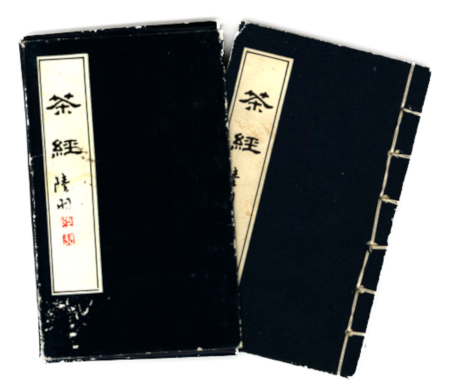
The "classic book about tea" The book by Lu Yu is the first professional treatise on tea ever. It is divided
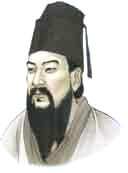
Lu Yu into 10 chapters and deals with topics such as the origin of the tea plant, production processes, methods and utensils for making tea and growing areas. It also contains an almost complete collection of historical texts dealing with tea.
Lu Yu (he lived 733-804) was abandoned by his (unknown) parents at the age of 3, found under a bridge by a Buddhist monk and was admitted to the monastery. There he made his first acquaintance with tea. At the age of 12 he escaped from the monastery and earned his living as a comedian. Later he met some literary friends and began to do research on tea. Around 764 he produced the first version of his book on tea. After several revisions the book was published in 780.
The character for tea:  (is spoken like "tscha" or "Cha" in Pinyin)
(is spoken like "tscha" or "Cha" in Pinyin)
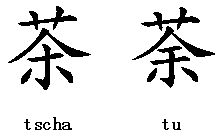 Before the Tang era there were different characters for the word "tea" in the Chinese language. The most commonly used character was "tu" (see figure 2). However, "tu" was actually the name of a bitter tasting vegetable. Because of the similarity in bitter taste, it was also used for tea. Later on, a variation of the character "tu" appeared: a stroke was omitted from the character. This variation was used in some unofficial texts instead of "tu" when referring to tea. When Lu Yu wrote his book, he chose this variation as the name for both the tea plant and the tea itself. Lu Yu's book achieved such a great influence in his time and afterwards that his spelling was also widely accepted.
Before the Tang era there were different characters for the word "tea" in the Chinese language. The most commonly used character was "tu" (see figure 2). However, "tu" was actually the name of a bitter tasting vegetable. Because of the similarity in bitter taste, it was also used for tea. Later on, a variation of the character "tu" appeared: a stroke was omitted from the character. This variation was used in some unofficial texts instead of "tu" when referring to tea. When Lu Yu wrote his book, he chose this variation as the name for both the tea plant and the tea itself. Lu Yu's book achieved such a great influence in his time and afterwards that his spelling was also widely accepted.
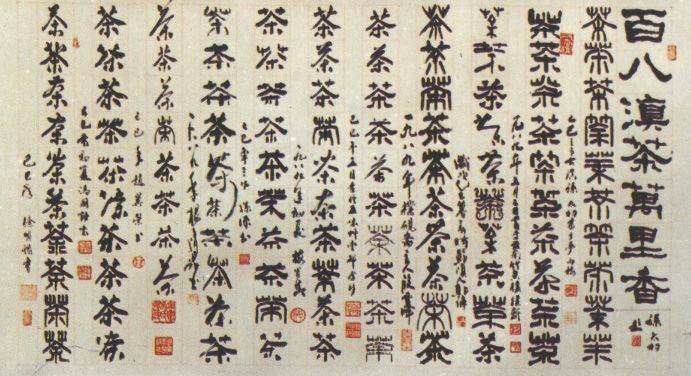 A calligraphy with 108 different spellings for Cha (tea)
A calligraphy with 108 different spellings for Cha (tea)
The significance of Lu Yu's book thus extends far beyond its scientific value. The book gave tea drinking a cultural aura. Although tea was drunk long before Lu Yu, the aesthetics of tea drinking were only now being discovered. Lu Yu not only provided information about which growing regions the best teas came from, where to find the best water for making tea and how to boil the water. He also thought about which colour of the tea bowl would harmonise best with the colour of the tea infusion. Lu Yu's book has made tea very popular among Chinese intellectuals.
Buddhism and tea
But Lu Yu's book was only one of the reasons why tea became so popular among writers during the Tang era. The development of tea culture in China was closely linked to the spread of Buddhism in China. Buddhism already came to China in the 2nd or 3rd century. But it was only the unification of the empire with its unprecedented expansion and the flourishing economy of the Tang period that enabled Buddhism to spread rapidly throughout China. The imperial court even elevated Buddhism to the status of state religion. The number of monasteries and monks increased explosively. The tangy taste of the simple tea embodied the simple, modest life of the monks in the monasteries in an ideal way, which is why the monks were the main consumers of tea in the Tang era. Drinking tea together was an integral part of the monks' monastic life. For the monks, tea was also a tried and tested means of inner concentration and spiritual stimulation during hours of meditation: The tea kept them awake while meditating.
 The largest sculpture in the Longmen Grottoes (World Heritage Site, Western China), Grand Vairocana Buddha, completed at the beginning of the Tang Dynasty, is 17.14 m high.
The largest sculpture in the Longmen Grottoes (World Heritage Site, Western China), Grand Vairocana Buddha, completed at the beginning of the Tang Dynasty, is 17.14 m high.
Many well-known writers of the Tang period were very close to the very spiritual Zen Buddhism, the form of Buddhism practised in China, and therefore very willingly adopted tea drinking as a beautiful lifestyle from the Buddhists. Lu Yu, author of the famous book on tea, for example, grew up as an orphan with a Buddhist teacher and later lived in seclusion in a Buddhist monastery to work on his book.
The economic factor tea
With the rapidly growing number of tea drinkers, the tea industry also grew at a fast pace.
There were tea plantations all over the catchment area of the Yangtze River. There were some famous tea plantations, especially in regions of today's
 Zhejiang
Zhejiang
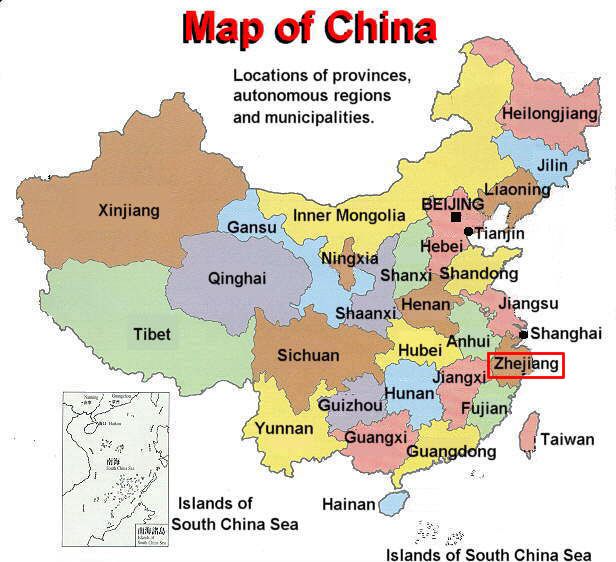 and
and
 Jiangsu.
Jiangsu.
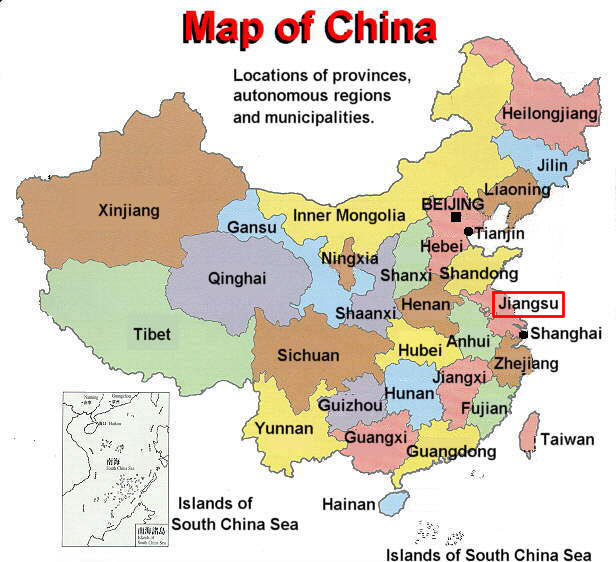 provinces.
The "Imperial Canal", completed around 610, connected the Yangtze River and the Yellow River, allowing tea from the tea-growing areas in Zhejiang and Jiangsu to reach the imperial court in Chang'an (today: Xi'an), which was located on the Yellow River, quickly.
By this time, southwest China had already lost its importance as the centre of the tea economy, probably also because of the very difficult transport connections.
The climate had also helped the rapid spread of tea plantations: the Tang period was one of the warmest periods in Chinese history, which meant that the tea plant could also be grown north of the Yangtze River.
Tea cultivation reached such a high level that the emperor levied a tax on the cultivation of the tea plant in order to reorganise the state treasury.
provinces.
The "Imperial Canal", completed around 610, connected the Yangtze River and the Yellow River, allowing tea from the tea-growing areas in Zhejiang and Jiangsu to reach the imperial court in Chang'an (today: Xi'an), which was located on the Yellow River, quickly.
By this time, southwest China had already lost its importance as the centre of the tea economy, probably also because of the very difficult transport connections.
The climate had also helped the rapid spread of tea plantations: the Tang period was one of the warmest periods in Chinese history, which meant that the tea plant could also be grown north of the Yangtze River.
Tea cultivation reached such a high level that the emperor levied a tax on the cultivation of the tea plant in order to reorganise the state treasury.
 Zhejiang
Zhejiang

 Jiangsu.
Jiangsu.

The processing of the tea remained with the pressed tea cake. However, the technique was refined: the fresh leaves were steamed, their juice was pressed out, then the leaves were dried in an oven and formed into the tea cake.
